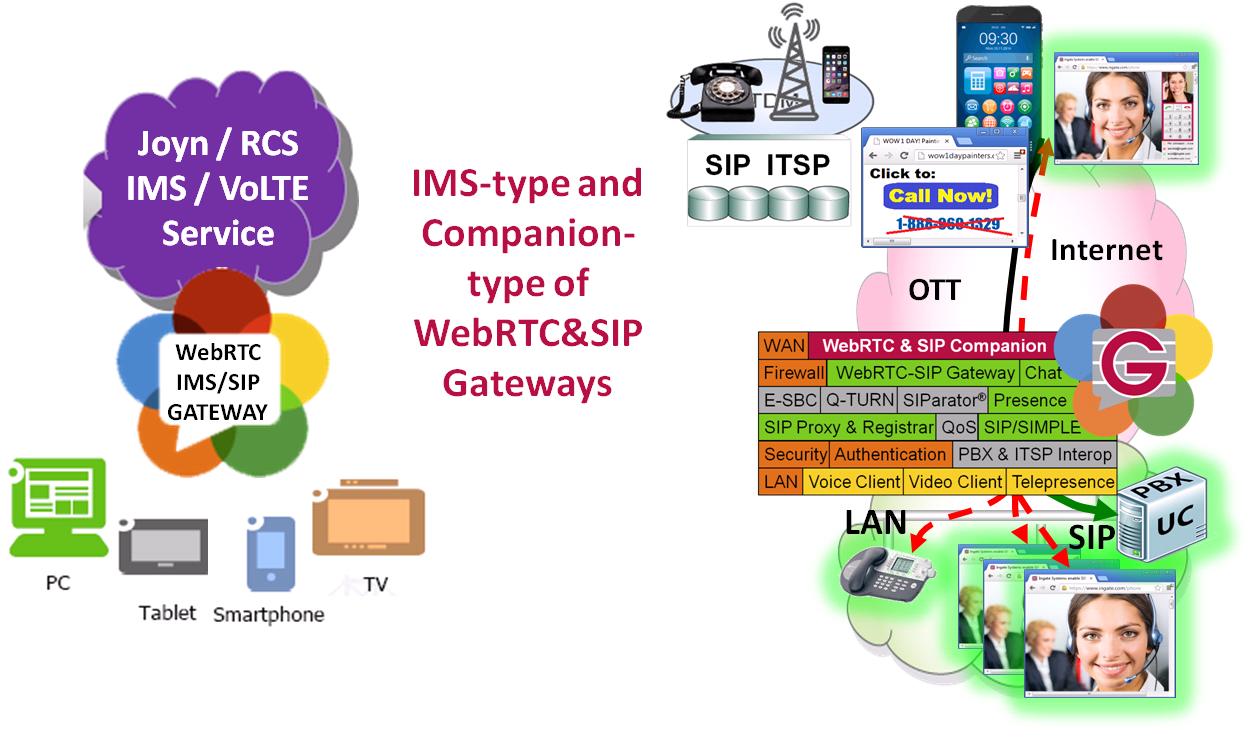WebRTC is an emerging IETF and W3C (News - Alert) standard for high quality real-time communication in web browsers. It opens up for new ways of communication, where integration with telephony is one of many.
Gateways between WebRTC and SIP (the protocol nowadays used for the telephony network) is an obvious component and seen by the IMS/VoLTE/RCS/Joyn multimedia telephony providers as a way to stretch their application-specific networks to Internet and OTT clients. However, more general and extended WebRTC and SIP gateways open up for Internet and OTT telephony usage directly at the user end, both enterprise and private.

Huge Savings With Web Click-To-Call 1-800 Replacement
Click-to-Call on websites is one of the obvious ways of connecting to call centers using WebRTC in the browser. You find the toll-free 1-800 numbers (and others) at the website, so instead of reaching for a telephone and dialing the number, simply click and the browser connects you to the contact center. The WebRTC call can directly be gatewayed to the SIP trunk interface of the call center with its IVR and queues, without passing the costly telephone network. Instead of spending four cents a minute for a toll-free number (used by 70 call agents at office hours), the call center will save $1 million dollars in telephone fees over a three-year period!

Such website click-to-calls are typically context-sensitive and integrated with CRM functions. Further, with a WebRTC and SIP gateway, including an E-SBC and also offering WebRTC clients for the PBX or UC solution, the free click-to-calls may use video, messaging and screen sharing functionality far beyond the plain old telephony service.
Such call center WebRTC usage is expected to explode when WebRTC becomes available in Microsoft’s and Apple’s browsers. Today these browsers need a plug-in – often based on code from Google’s Chrome, the most popular browser that along with Firefox already implements WebRTC.
Superior WebRTC Clients Replace Desktop Phones and Challenge Telepresence (News - Alert) Systems
Traditional POTS with pre AM-radio quality voice that we still use for global real-time communication has 50 years of lost Moore’s law development to recover. Within the enterprise, the plain PBX has become unified communications solutions, and there are initiatives like OVCC to make telepresence communication global.
WebRTC allows our devices to use their HD video and better voice quality over broadband Internet and OTT access, and the extended WebRTC and SIP gateway can pave the way for a modern telephone service.
A plain WebRTC and SIP gateway typically has a SIP-over-Websocket signaling interface and converts RTP media between the two standards. You then can build full SIP clients in Java script in the browser. However, a full SIP client is an extensive and heavy Java script application and WebRTC and SIP gateways may therefore include most of the SIP soft client and provide a high-level API to write a thin soft client. A simple click-to-call client can then be a few lines of Java script to integrate on customers’ websites, while there also can be extended gateway functionality allowing high-end multiparty videoconferencing with screen-sharing and more.

Smartphone App Clients Using WebRTC Protocols Redefine Mobile Telephony
Browsers aren’t best equipped for mobile telephony, and there aren’t yet WebRTC browsers for the iPhone. However, thin high-quality client apps for both iPhone and Android (News - Alert) using the WebRTC protocols and media engine are coming. For a Companion-type of WebRTC and SIP gateway, such apps use the high-level interface having the major SIP user agent functionality ready to use.

WebRTC’s Built-in NAT/Firewall Traversal, Built-in E-SBC and TURN
Server Between the LAN and WAN Allow Connectivity Everywhere
For the first time with IP telephony we can get connectivity everywhere, and OTT VoIP can really compete with mobile phones over their own networks.
The inability of real-time communication to traverse NATs and firewalls that has plagued IP telephony since its beginning is resolved by STUN/TURN/ICE, and the upcoming standard for network-provided TURN servers (called Q-TURN by Ingate) will also enable high-quality WebRTC communication on the most restrictive private enterprise LANs.
WebRTC’s connectivity everywhere you can surf redefines telephony:
- Your smartphone app will be your PBX/UC extension phone, everywhere you are – and the fixed-line SIP trunk provider will be an OTT virtual mobile operator.
- There will be superior low-cost volume mobile telephony services, where only the Internet (fixed or Wi-Fi) and OTT data path of 3G/4G/LTE is used.
- Desktop and DECT phones will be obsolete. The thin WebRTC and SIP client, either in the browser or as an app in the smartphone, can finally replace other phone types.
- Carriers selling managed voice no longer need to provide hard phones. The continuation of SIP trunking can be a WebRTC gateway included in their E-SBCs serving as their demarcation point to the customer.
Karl Stahl is CEO of Ingate Systems AB (www.ingate.com).
Edited by Stefania Viscusi




